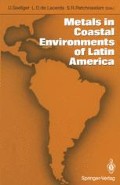Abstract
So called “heavy metals”, transition metals, some of which are necessary in small concentrations to living systems, and which at higher concentrations are toxic to aquatic biota, are common pollutants because of their diverse industrial uses. Maximum permitted concentrations and quantities in aqueous effluents and in surface waters which are considered not to cause intolerable damage, have been established in the legislations of many countries. However, it is known that these metals, originally dissolved in water, are absorbed by sediments so that even after the cessation of industrial emission the sediments will contain stocks of absorbed metals which may be remobilized and become available to the biosystem with toxic effects, either by direct biological interaction with the sediment (benthic organisms) or by the subsequent physical disruption of the sediment (e.g. resuspension by dredging or during river flooding) (Duinker and Notting 1977). Sediments also contain heavy metals of natural origin, but it is likely that the chemical speciation of the metals with natural and anthropogenic origin will be different, the latter occuring in more labile forms. A considerable fraction of the metals of natural origin will occur as trace components of stable minerals. The precipitated and/or absorbed anthropogenic metals may be remobilized by variations in redox conditions or in pH.
Access this chapter
Tax calculation will be finalised at checkout
Purchases are for personal use only
Preview
Unable to display preview. Download preview PDF.
References
Duinker JC, Notting RF (1977) Dissolved and particulate trace metals in the Rhine Estuary and the Southern Bight. Mar Poliut Bull 8: 56–71
Megalatti N, Robbe O, Marchandise P, Astruk M (1983) A new chemical extraction procedure in the fractionation of heavy metals in sediments. Proc Inter Conf Heavy Metals Environ 4: 1090–1093
Author information
Authors and Affiliations
Editor information
Editors and Affiliations
Rights and permissions
Copyright information
© 1988 Springer-Verlag Berlin Heidelberg
About this chapter
Cite this chapter
Maddock, J.E.L., Lopes, C.E.A. (1988). Behaviour of Pollutant Metals in Aquatic Sediments. In: Seeliger, U., de Lacerda, L.D., Patchineelam, S.R. (eds) Metals in Coastal Environments of Latin America. Springer, Berlin, Heidelberg. https://doi.org/10.1007/978-3-642-71483-2_11
Download citation
DOI: https://doi.org/10.1007/978-3-642-71483-2_11
Publisher Name: Springer, Berlin, Heidelberg
Print ISBN: 978-3-642-71485-6
Online ISBN: 978-3-642-71483-2
eBook Packages: Springer Book Archive

